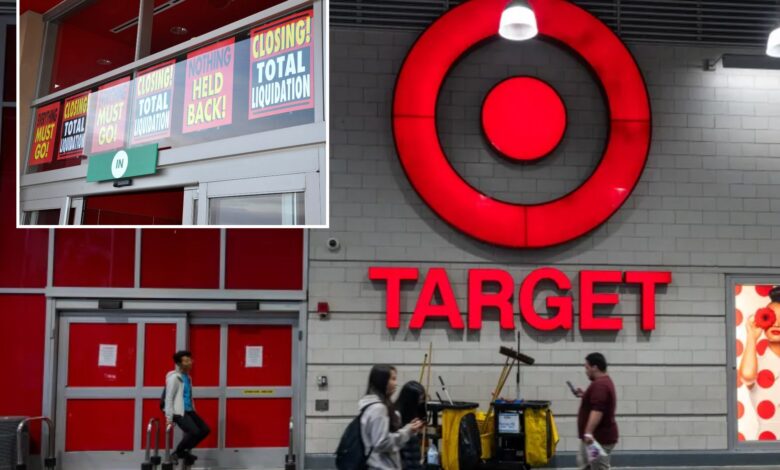Target sales bounced back after closing crime-prone stores

Target’s sales and customer traffic bounced back this week after it closed crime-afflicted stores – suggesting more retailers may begin shuttering locations over shoplifting, sources told The Post.
The “cheap chic” discounter posted earnings and revenue that beat Wall Street’s forecasts on Wednesday as markdowns lured inflation-weary shoppers. But Target COO Michael Fiddelke also cited a decrease in “inventory shrink” – or losses from shoplifting – for the company’s rebound.
Target said it was making “progress” addressing its shrinkage. The retailer closed nine crime-prone stores last year, in cities like NYC and Seattle.
If such retail retreats become a wider trend — and experts warn that they will if cities fail to crack down on crime — shoppers could get trapped in “retail deserts” with nowhere to turn for affordable clothing, food and prescription medicines, according to experts.
“There is a very real possibility we will see retail deserts in high crime areas,” said Gene Petrino, a retired SWAT commander who is co-owner of Survival Response, which helps companies train employees to deal with workplace violence.
In 2022, shrinkage cost Target a whopping $700 million in profits, according to past earnings reports. The retailer estimated it lost another $500 million in 2023, according to past earnings reports.
“[We] cannot continue operating these stores because theft and organized retail crime are threatening the safety of our team and guests, and contributing to unsustainable business performance,” Target said last September.
Patrick McCall, the president and CFO of McCall Risk Group, told The Post he has heard rumblings that other large box retailers, including companies owned by TJX Brands, are considering store closures in Chicago.
TJX — which owns big-name chains including TJ Maxx, Marshalls and HomeGoods — didn’t immediately respond to a request for comment.
While there are other paths to take besides store closures, these options are similarly unpopular. Stores can put more items under lock and key in cabinets – which frustrates customers and Instacart shoppers alike.
“Thieves are not deterred and will smash the cabinets in an attempt to grab the merchandise,” McCall told The Post.
“It also becomes a customer service issue because a lot of these retailers are short-staffed to begin with and now do not have the manpower to have additional employees on the sales floor to open up these cabinets or displays every time a customer needs a product.”
Robberies, grand larceny and petit larceny in NYC spiked 86% between 2017 and 2023, according to New York Gov. Kathy Hochul.
Inventory shrink grew to $112.1 billion across the industry in 2022 – up nearly $20 billion from the year before, according to a report by the National Retail Federation.
At the time, David Johnston, the NRF’s vice president for asset protection and retail operations, said “the situation is only becoming more dire.”
Target’s success after shuttering crime-ridden stores “could be a big harbinger,” Burt Flickinger III, managing director of Strategic Resource Group, told Marketwatch.
Drugstores like CVS and Walgreens – which said it would close up to 2,000 stores this year – have also been shuttering stores across the country.
CVS announced plans in 2021 to shutter 900 stores: 300 each in 2022, 2023 and 2024. While shrinkage likely plays a role, CVS has said the store closures cannot be attributed to a single factor.
Stop & Shop said it will close 32 locations this year as shoppers turn to more affordable grocery stores.
Home goods chains are struggling, too. Big Lots said it will close between 35 and 40 stores this year, while Conn’s has fallen into bankruptcy and shuttered its Bob’s Stores locations.
“Unfortunately, due to the increase in violence against loss prevention employees, many stores have decided to have a ‘hands-off’ policy for apprehending shoplifters,” Petrino told The Post. “This has become common knowledge among criminals…making the problem worse.”
California Gov. Gavin Newsom signed 10 bills into law last Friday to crackdown on retail theft.
The bills raise penalties and fines for shoplifting, theft from a vehicle, organized theft and the resale of stolen goods.
California only charges shoplifters who steal more than $950 worth of goods with a felony. Critics have said California’s penalties are too relaxed – though the state’s felony threshold is tougher than those in neighboring Oregon, Nevada and Arizona.
Without a better solution, empty storefronts may become more common.
The retail environment today is reminiscent of NYC in the 1970s and 1980s, when crime “drove out not hundreds of thousands of residents…but also many businesses,” according to Steven Malanga, a senior fellow at the Manhattan Institute.
“Within a few years, entire communities lacked basic amenities like supermarkets and drugstores; empty storefronts littered shopping districts,” Malanga predicted.




